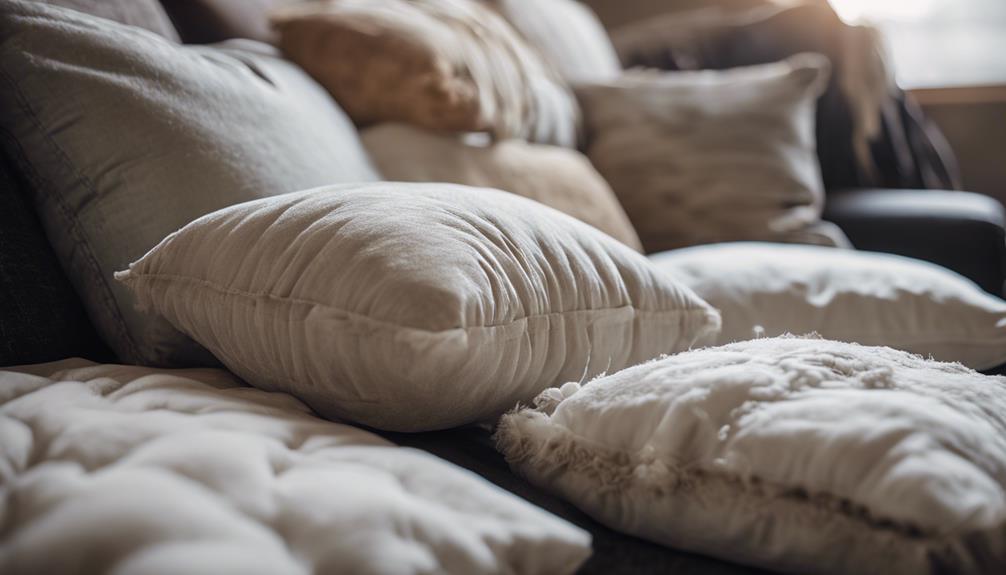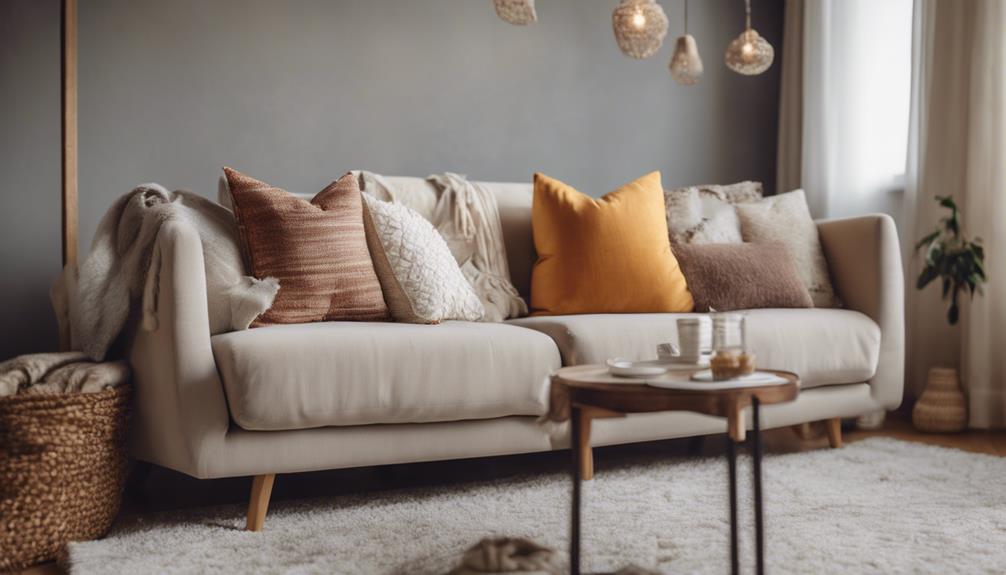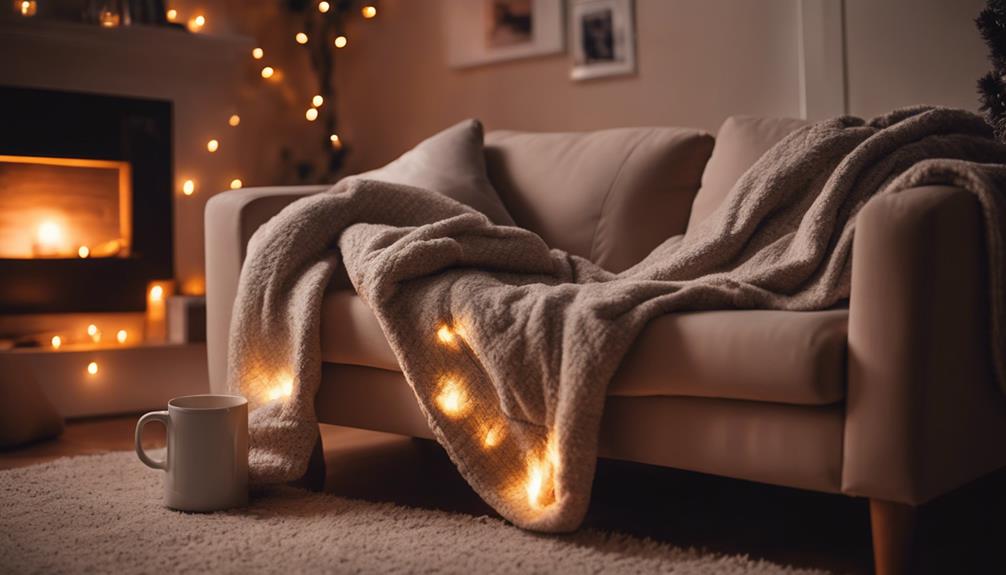When determining how long to keep throw pillows, it’s important to consider the type and maintenance. Down and feather pillows can last 5-10+ years with regular washing, while synthetics typically last 1-2 years. The longevity of foam pillows can vary. Keep an eye out for signs such as faded colors, loss of shape, and lack of support, as these are indications that it may be time to replace them. Proper care and storing in cool, dry places can help prolong their lifespan. Rotating and using pillow covers can also aid in maintaining their appearance and freshness. Spot cleaning in between washes is crucial. Changing throw pillows every 1-2 years can help refresh your decor. If you would like to learn more about maximizing the lifespan of your throw pillows, click here.
Note for clarity: The text has been rephrased while maintaining the original sentiment and meaning.
Key Takeaways
- Replace throw pillows every 1-2 years to maintain freshness and comfort.
- Regularly changing throw pillows refreshes home decor and hygiene.
- Updating throw pillows instantly updates room aesthetics without major renovations.
- Prevent wear and tear by swapping out throw pillows every 1-2 years.
- Customizing throw pillows suits different tastes and moods easily.
Pillow Lifespan Expectancy
When it comes to pillow lifespan expectancy, the durability of different types varies greatly. Down and feather pillows have a longer lifespan, lasting anywhere from 5 to 10 years or more with regular washing every 6 months. This type of pillow can stand the test of time if properly cared for.
On the other hand, synthetic pillows typically last between 1 to 2 years, depending on the quality of the material and how frequently they're used. These pillows may show signs of wear sooner, such as clumping or becoming flat.
Foam pillows fall in between, with longevity depending on the quality of the foam and how often they're used. Over time, foam pillows may become harder as a natural consequence of use.
Regular maintenance, such as washing and fluffing, can help extend the lifespan of down and feather pillows, ensuring you get the most out of your investment.
Signs It's Time to Replace

When considering whether it's time to replace throw pillows, paying attention to signs like faded colors and flat cushions can be key indicators.
Over time, pillows may lose their vibrancy and fullness, making them less visually appealing and supportive.
Faded Colors
The faded colors on our throw pillows suggest that it's time to contemplate replacing them due to sun damage and wear over time. Pillow covers exposed to excessive sunlight can fade faster, impacting the overall aesthetic of the room. When colors fade unevenly, it can detract from the vibrancy we desire.
To maintain a fresh look, consider replacing throw pillows with faded colors. Regularly rotating pillows can help prevent this issue, extending their lifespan. By addressing faded colors promptly, we can uphold a cohesive and appealing decor.
Flat Cushions
Considering the comfort and aesthetic appeal of your living space, it becomes essential to replace flat cushions showing signs of wear like visible lumps or uneven filling distribution.
When your throw pillows no longer provide the support or comfort they once did, it's time to replace them. If you notice that your pillow remains compressed even after fluffing, this is a clear indication that it needs replacing.
Overused cushions may lose their shape, failing to bounce back to their original form. Don't overlook the importance of replacing flat cushions that no longer enhance your seating comfort or the overall look of your space. Keep an eye out for these signs and be proactive in replacing your pillows when needed.
Prolonging Pillow Lifespan

Regular care and maintenance play an important role in extending the lifespan of your throw pillows. By implementing proper storage techniques, regular cleaning routines, and rotating your pillows for even wear, you can greatly increase their longevity.
These simple steps can help preserve the quality and comfort of your pillows for years to come.
Pillow Storage Tips
For ideal pillow storage and to prolong their lifespan, prioritize selecting appropriate storage containers such as storage benches, labeled boxes, plastic bins, or baskets. Avoid squishing pillows into containers as it can cause damage.
Store pillow covers flat and consider removing inserts if needed for better storage. Opt for cool, dry storage spaces to prevent mold, mildew, and pest infestations.
Utilize vacuum storage bags for space-saving benefits, but make sure proper air circulation to prevent condensation. By following these storage tips and rotating pillows every season, you can maintain their quality and extend their lifespan effectively.
Remember that proper storage plays a significant role in preserving the comfort and durability of your throw pillows.
Cleaning Throw Pillows
To maintain the longevity of your throw pillows, washing the pillow covers every 2-4 weeks is crucial for cleanliness and hygiene. Regular cleaning not only helps remove dirt and allergens but also preserves the quality of materials used in the pillows.
When cleaning, it's important to pay attention to the type of material your pillows are made of. Fragile material pillows should be hand-washed in warm water and air-dried to prevent damage and maintain their quality. Additionally, when drying pillows, avoid high heat as it can distort the shape of the pillows and reduce their lifespan.
Rotation for Even Wear
Ensuring that we rotate throw pillows regularly is crucial for maintaining their shape and promoting even wear. By flipping and rotating the pillows every 1-2 weeks, we can prevent them from becoming excessively flat, thus extending their lifespan.
Distributing pressure evenly on the pillows through rotation helps prevent lumps or sagging in specific areas, keeping them looking new. Rotating pillows based on their usage patterns is key to avoiding uneven wear and ensuring consistent appearance.
Establishing a rotation schedule for throw pillows is a straightforward yet effective method to preserve their quality and increase their longevity. By incorporating this practice into your pillow care routine, you can enjoy their comfort and visual appeal for a longer period.
Benefits of Rotating Pillows

Regularly rotating throw pillows guarantees even distribution of wear and tear, maintaining their quality and appearance over time. By implementing this simple practice, we can enjoy a range of benefits that contribute to the longevity and aesthetics of our throw pillows.
Here are some advantages of rotating pillows:
- Even Wear and Tear: Rotating pillows helps distribute usage evenly, preventing certain pillows from wearing out faster than others.
- Prevention of Misshaping: It reduces the risk of specific pillows becoming excessively flattened or losing their shape.
- Maintained Appearance: Regular rotation preserves the overall look and feel of the pillows, keeping them looking fresh and plump.
- Extended Lifespan: By reducing strain on particular areas, rotation can help extend the lifespan of throw pillows.
- Aesthetic Refreshment: Alternating pillows can introduce variety and refresh the aesthetic appeal of a space regularly, giving it a new look without the need for new pillows.
Using Pillow Covers Effectively

When considering how to effectively use pillow covers, it's essential to understand their role in protecting throw pillows from dirt, spills, and everyday wear and tear. Pillow covers act as a barrier, preventing stains and grime from reaching the actual pillow. To make sure your throw pillows stay clean and fresh, using pillow covers is key.
Not only do they shield your pillows from damage, but they also make maintenance easier. By opting for machine washable pillow covers, cleaning becomes a breeze, reducing the need to wash the entire pillow frequently.
Additionally, pillow covers offer a convenient way to switch up the look of your throw pillows without breaking the bank. With various materials, colors, and patterns available, you can effortlessly transform the appearance of your pillows to suit different styles and seasons.
Importance of Spot Cleaning

To maintain the appearance and freshness of throw pillows, spot cleaning plays an important role in targeting stains and spills without the need to wash the entire pillow. Spot cleaning is especially vital in high-traffic areas like the living room, where throw pillows are often used for comfort and decoration.
Here are some key points to keep in mind when spot cleaning your throw pillows:
- Spot cleaning helps preserve the look of your throw pillows between washings.
- It allows you to address stains promptly, preventing them from setting in.
- Regular spot cleaning can extend the lifespan of your throw pillows, reducing the frequency of full washings.
- Delicate or dry-clean only throw pillows benefit greatly from spot cleaning to avoid damage.
- Using the right cleaning products and techniques ensures effective spot cleaning results without compromising the fabric or colors of your throw pillows.
Refreshing Home Decor Regularly

Updating home decor can be easily achieved by regularly changing throw pillows every 1-2 years. By revamping your throw pillows, you can instantly update the look and feel of a room without undertaking a major renovation.
This simple change not only adds a new touch of style but also helps maintain cleanliness and hygiene in your living spaces. Whether you prefer bold patterns, soft textures, or seasonal themes, swapping out throw pillows allows for easy customization to suit your taste and mood.
Additionally, regularly updating your throw pillows can prevent wear and tear, keeping them looking fresh, vibrant, and comfortable. This cost-effective strategy enables you to adapt your decor to different seasons or trends without breaking the bank.
Frequently Asked Questions
How Often Should You Replace Throw Pillows?
When it comes to replacing throw pillows, it's crucial to take into account their age and condition. Regular replacement every 1-2 years is recommended to maintain cleanliness and support.
Cheaper pillows from stores like Target or Walmart might need replacing every 6 months to a year. Remember, old pillows can harbor dust mites and bacteria.
Investing in custom-made, high-quality pillows can last up to a decade with proper care, making them a worthwhile choice for longevity.
When Should You Throw Away Pillows?
When it's time to throw away pillows, keep an eye out for signs like clumping, flatness, or a pillow that indicates the end of its lifespan. These indicators suggest the pillow has reached the end of its lifespan.
For down and feather pillows, this could be after 5-10 years of regular washing. Synthetic pillows typically last 1-2 years, while foam pillows' durability varies. Assess your pillows regularly to guarantee a good night's sleep.
How Long Are Throw Pillows Good For?
Throw pillows are good for around 2-5 years, depending on usage and maintenance. Regular washing and fluffing can help extend their lifespan.
Synthetic pillows may need replacing sooner than down or feather ones, which can last longer with proper care.
How Often Should I Replace Down Pillows?
When it comes to replacing down pillows, it's recommended every 5-10 years for best comfort and support. Regular washing every 6 months can help extend their lifespan.
Signs like losing fluffiness even after cleaning, clumps, or flatness indicate it's time for a new pillow. Using pillow covers is a good practice to help them last longer.
Proper care is key to keeping your down pillows in good shape.
Conclusion
To sum up, maintaining throw pillows fresh and comfortable is crucial for a cozy home environment. By understanding the lifespan of your pillows and recognizing when it's time to replace them, you can guarantee a clean and inviting space.
Remember to rotate your pillows, use covers effectively, and spot clean regularly to prolong their lifespan.
By updating your home decor regularly, you can create a welcoming atmosphere that symbolizes comfort and relaxation for you and your guests.









